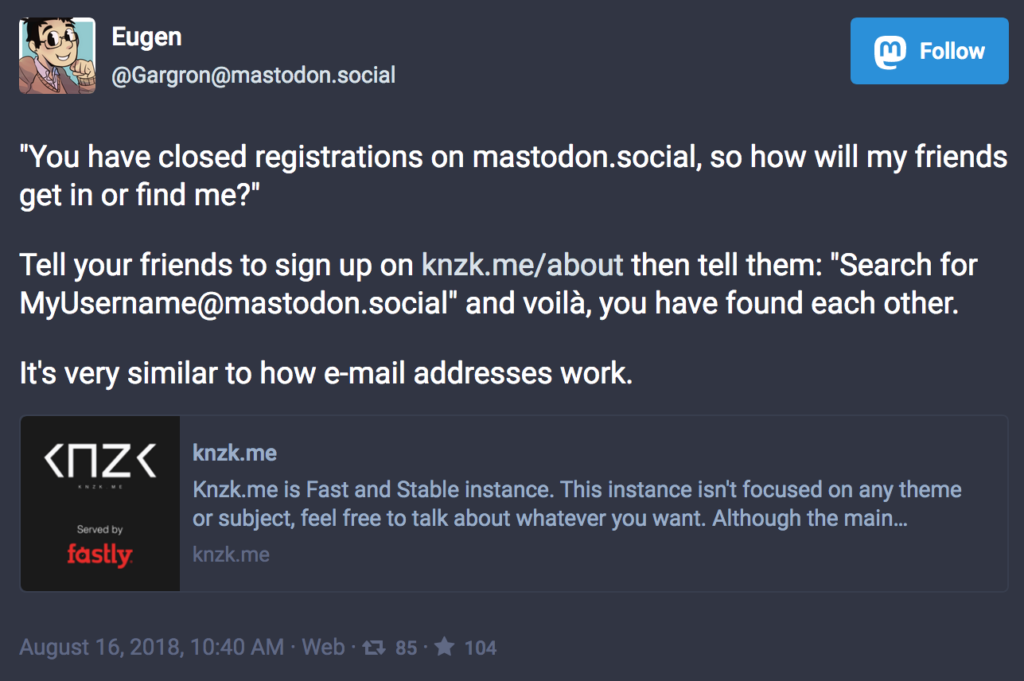The Missing Element in the Fediverse
Today, Eugen, the creator of Mastodon, the Fediverse’s probably most popular instance implementation, tooted this:

He’s basically quickly explaining to newcomers how to find someone whose account lives on a different instance – something that might be understandably foreign to people used to silos like Twitter or Facebook. But then he adds:
It’s very similar to how e-mail addresses work.
That’s something that’s been bothering me for a while about the Fediverse: it’s not clear how a Fediverse service like Mastodon relates to someone’s online identity. The added element of having multiple instances to choose from is often compared to e-mail, where people can choose between Gmail and Hotmail and Yahoo and thousands of other providers, while still being able to communicate… but the important difference is that email lets you decouple your identity from your service provider. You can be john@doefamily.com, with your email hosted with Google or Fastmail or whoever else you want. And if you want to switch providers, you can do so without having to tell anybody: they still email you, and receive emails from, the same address as before.
That’s not the case (yet) with the Fediverse. If you’re @johndoe@mastodon.social but want to move to pawoo.net, you’d have to migrate your profile and tell people to follow you over there.
I suppose that a technical solution is possible, and might follow the same model as e-mail, where mail servers first ping the receiver’s domain’s DNS table and ask for the actual mail server via MX records. There’s also some other more complex stuff on the receiving end to prevent spam via other DNS records like SPF and DKIM. Mastodon, or any other Fediverse server, could similarly ping doefamily.com and see that @john@doefamily.com is hosted on pawoo.net, thus sending a notification to @johndoe@pawoo.net.
The question is: should it?
I have no idea. That’s the other thing that bugs me: the Fediverse seems still unsure about what it is – it’s only sure about what it’s trying to be and not to be.
For instance, someone proposed recently that the term “instances”, which comes from a rather technological background, be replaced with the term “communities”, to show that this is more about finding a place where you feel “at home”. Since the whole point of the Fediverse is to be able to communicate with other instances, it might seem odd to have to pick an instance based on other factors than price/performance1, but the reality is that instances have different moderation policies, might block other instances, and, more importantly, the UX (at least with Mastodon) gives a prominent place to your instance’s Timeline compared to the rest.
As such, Fediverse instances look to me like Twitter’ified versions of internet forums where you can also reply to threads from other forums. Maybe you’re @ilovepikachu@pokemon.social and you talk about Pokemon all day long, but sometimes you also talk politics by replying to someone on anticapitalist.party… but does that even make sense? Wouldn’t you just have a profile on each instance/community, using each profile appropriately, the same way we’ve had different accounts on a handful of forums since the late 90s?
The answer, of course, is often a vague “it depends”. The Fediverse is what you make of it… or something. But for a technology predicated on “taking back what’s yours” from the evil Silicon Valley corporations, the Fediverse doesn’t seem to have a good story about how you can own your identity and your data. I guess that’s what the IndieWeb movement is trying to address more directly.
In the meantime, I maintain my own Mastodon instance – something I don’t need to do for my e-mail.
-
Who would pick an email server where all customers are into Anime?! ↩︎